The Larch Guide
Larches (genus Larix) are unique among conifers—they are one of the few deciduous conifer species, shedding their needles in fall after a vibrant golden display. Known for their feathery foliage, pyramidal shape, and seasonal interest, larches bring dynamic texture and movement to the landscape. Their upright or weeping forms, adaptability to cold climates, and bold color shifts make them standout focal points in gardens that appreciate structure and change.
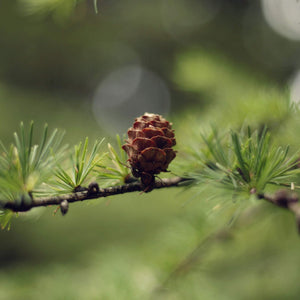
About
Larches are native to cool, temperate regions of the Northern Hemisphere, thriving in mountain ranges and boreal forests. In landscapes, they offer a rare blend of evergreen-like form with the drama of autumn leaf drop.
The three primary species used ornamentally in North America include:
- Larix decidua (European Larch): A tall, fast-growing tree with a classic conical form. Cultivars like ‘Pendula’, ‘Puli’, and ‘Horstmann’s Recurva’ offer unique weeping or twisted habits ideal for specimen use.
- Larix laricina (Tamarack or American Larch): Native to much of northern North America, often found in wetlands and cold climates. Compact cultivars like ‘Blue Sparkler’ have a silvery-blue cast and lacy texture.
- Larix gmelinii (Dahurian Larch): Hardy to extremely cold temperatures, this species includes selections like ‘Romberg Park’, known for its compact, ornamental form.
All larches have soft, needle-like foliage arranged in whorls around their branches. Their bright green spring growth matures to a rich green in summer before turning golden yellow in fall. By winter, they stand bare, revealing graceful branch structures that bring visual interest to leafless months.
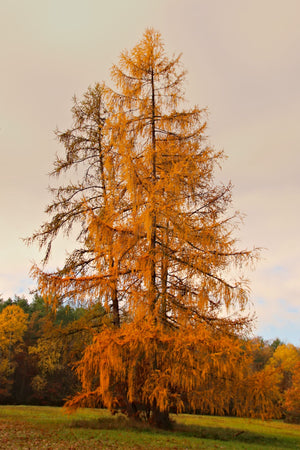
PLANTING
Larches thrive in cool climates and full sun, with the right site selection critical for long-term success.
USDA Hardiness Zones:
- Larix decidua: Zones 3–6
- Larix laricina: Zones 2–5
- Larix gmelinii: Zones 2–5
Soil: Prefers moist, well-drained soil that is slightly acidic. Larches do not tolerate drought or heavy, compacted soils well. Native tamaracks (Larix laricina) adapt better to wet, boggy ground.
Sunlight: Full sun is essential. Larches become thin and leggy in shade, and poor light can reduce fall color and overall health.
Watering: Maintain even moisture, especially during the first 2–3 years. Once established, most larches tolerate periodic wet or dry spells, but consistent hydration supports best performance.
Spacing:
- Full-sized forms (e.g., Larix decidua): space 20–30 feet apart
- Weeping or dwarf forms: 6–12 feet depending on spread and training
Planting Time: Early spring or early fall is best, allowing time for root establishment before extreme temperatures set in.
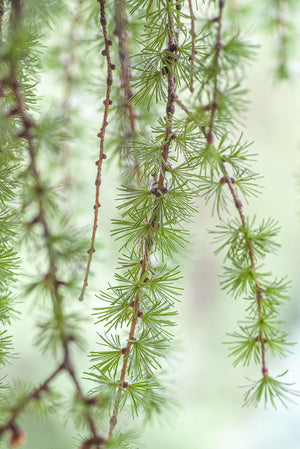
CARE
Once established, larches require little maintenance and reward gardeners with strong seasonal changes and architectural shape.
Watering: Deep water during prolonged droughts. Soil should be moist but not waterlogged.
Fertilizing: In early spring, a balanced, slow-release fertilizer can support new growth if soils are poor. Avoid high-nitrogen formulas that encourage weak growth.
Pruning:
- Larches respond well to pruning but rarely need it unless shaping weeping forms.
- Prune in late winter or early spring before new growth begins.
- Remove any dead, damaged, or crossing branches, and stake young weeping varieties to train form.
Pests & Diseases: Generally pest-free. Possible concerns include larch sawfly or needle cast in overly wet environments, but healthy larches are rarely impacted.
Mulching: Apply 2–3 inches of mulch around the root zone to regulate temperature and retain soil moisture. Keep mulch away from the base of the trunk.
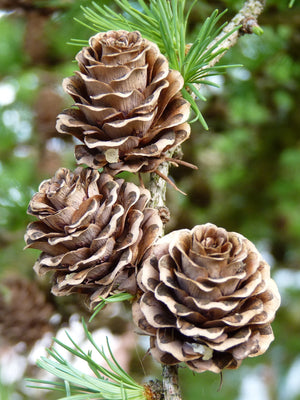
HOW TO USE
Larches are ideal for gardeners seeking bold, structural trees that offer year-round interest—including seasonal color and striking winter silhouettes. Their deciduous needles and unique textures make them excellent focal points and conversation pieces.
Focal Point: Upright forms like Larix decidua ‘Prag’ or the twisted, cascading branches of ‘Horstmann’s Recurva’ make exceptional focal points in open lawns, rock gardens, or near water features. Their dramatic color shifts and elegant forms stand out in all seasons.
Weeping Sculptural Trees: Cultivars like ‘Puli’ or ‘Pendula’ can be trained over arches, staked into pillars, or allowed to drape freely over slopes or rock walls. These make excellent statement plants in Japanese gardens, courtyards, or beside stone paths.
Naturalistic Plantings: Use American larch (Larix laricina) in native or rewilded gardens, especially near wetlands or ponds. Their upright, airy habit complements birch, red-twig dogwood, and sedges.
Mixed Borders and Woodlands: Pair larches with other deciduous and coniferous trees for layered interest. Ideal companions include:
- Spring color: Fothergilla, serviceberry, redbud
- Fall companions: Ginkgo, oakleaf hydrangea, witch hazel
- Evergreens for contrast: dwarf spruce, hemlock, or Chamaecyparis cultivars
Winter Gardens: Bare larch branches take on an ornamental quality in snow-covered gardens or against evergreen backdrops. Position near pines or boxwoods to accentuate their structure.
Bonsai and Dwarf Plantings: Some compact cultivars like Larix decidua ‘Horstmann’s Recurva’ or Larix laricina ‘Blue Sparkler’ are used in bonsai or container gardens, particularly for collectors seeking unique winter interest.
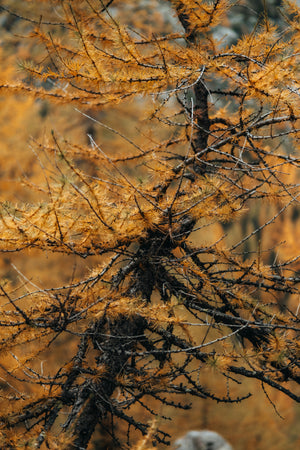
Common Questions
What is larch? Larch is a deciduous conifer—a cone-bearing tree that sheds its needles each fall. Native to the Northern Hemisphere, it’s known for its golden autumn foliage, pyramidal form, and soft, needle-like leaves.
What is larch wood used for? Larch wood is strong, durable, and naturally rot-resistant. It’s commonly used in construction, decking, fencing, boatbuilding, and outdoor siding due to its resistance to decay and attractive grain.
Where do larch trees grow? Larches grow in cool-temperate and boreal climates. Native American larch (Larix laricina) is found across Canada and the northern U.S., while European larch (Larix decidua) and Dahurian larch (Larix gmelinii) are common in Europe and Asia.
Do larch trees lose their needles? Yes. Larch is one of the few conifers that is deciduous. Needles turn golden yellow in fall before dropping, leaving a bare but striking branch structure in winter.
Is larch a hardwood? No. Botanically, larch is a softwood because it is a conifer. However, it has very dense, strong wood that behaves like a hardwood in construction and woodworking applications.
When do larches turn yellow? Larch trees typically change color in mid to late fall (October in most temperate regions), turning bright yellow or gold before shedding their needles.
How tall do larch trees grow? Mature larches can reach 50–80 feet tall depending on species and conditions. Dwarf and weeping cultivars are typically much smaller, staying under 10–20 feet depending on pruning and staking.
Do deer eat larch? Larch is generally deer-resistant. The foliage is not a preferred food, especially once the tree matures. Young saplings may be vulnerable to browsing in harsh winters.
Do larch need full sun? Yes. Full sun is essential for healthy growth, dense branching, and vibrant fall color. Larch will not thrive in shade and may become sparse and weak without adequate light.
How to prune larch? Prune in late winter or early spring before new growth begins. Remove dead or damaged branches, shape young trees, and train weeping cultivars using stakes. Avoid hard pruning into old wood unless necessary.
Conclusion
Larches are distinctive, cold-hardy conifers that bring drama and seasonality to the landscape. Their golden fall color, soft spring growth, and sculptural winter form create a year-round spectacle. Whether used as a centerpiece in a small garden, a cascading accent on a slope, or a native addition to a wetland planting, larch trees offer texture, beauty, and adaptability in cooler climate gardens.
The Larch Collection
Sold Out
Sold Out
Sold Out
Sold Out
Sold Out






